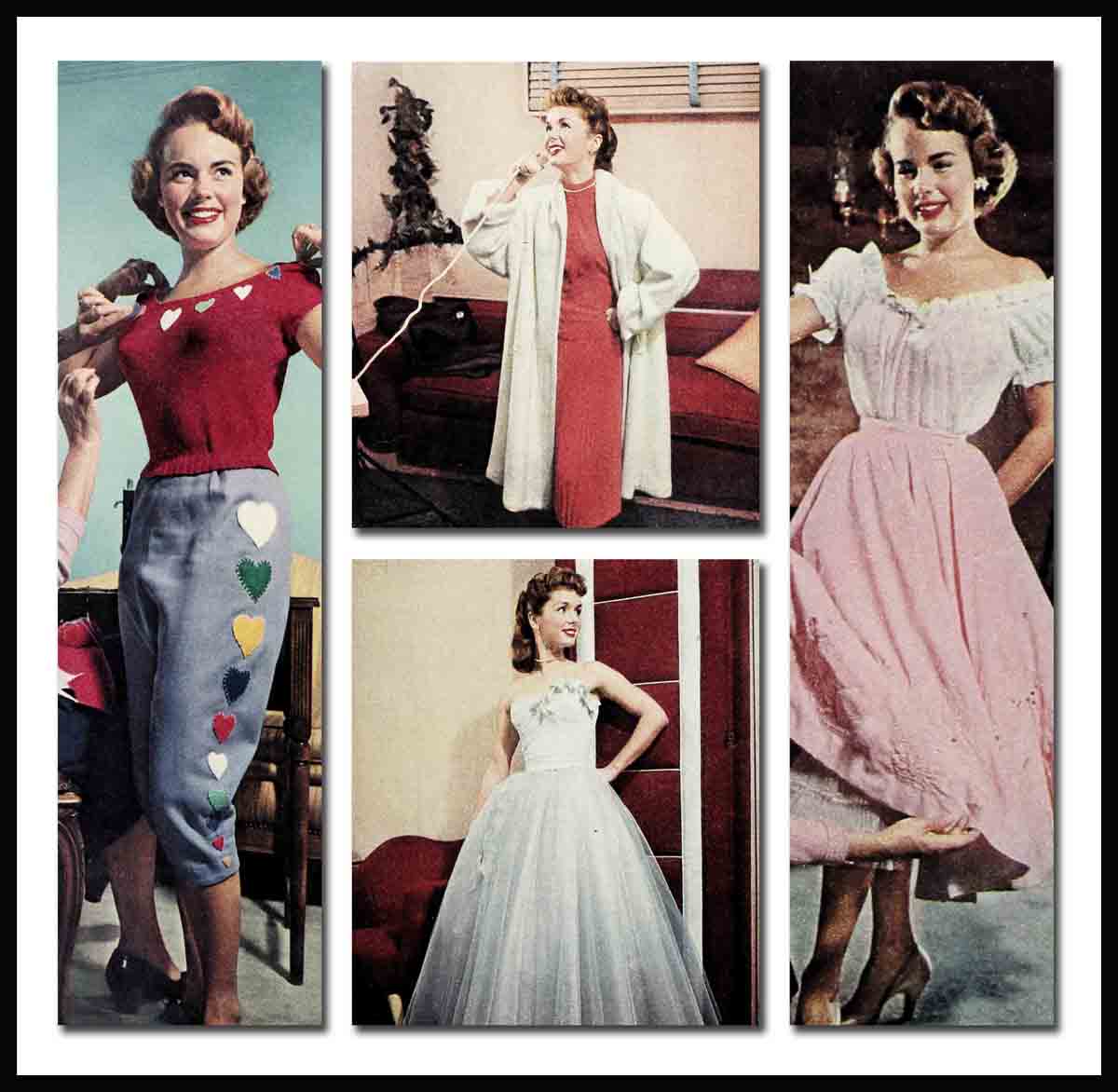
Make Your Own Clothes
“As soon as Eve ate the apple of wisdom, she reached for the fig leaf; when a woman begins to think, her first thought is of a new dress.”
That was the considered opinion of poet Heine over a hundred years ago. And he was so right.
For some Hollywood dolls, a new dress entails an expensive jaunt to Don Loper or Saks Fifth Avenue. No so, however, for a quartet of the luckiest clotheshorses in town—Terry Moore, Debbie Reynolds, Marge Champion and Leslie Caron. Their fashion salons are right at home—snugly encased in completely equipped sewing rooms. And when fashion-conscious pals of these stars see the distinctive fabrics individually designed into perfect-fitting clothes and inexpensively executed on home sewing machines, their eyes—normally blue or gray or brown—turn a bright green with jealousy.
Terry Moore and Debbie Reynolds, lucky dolls, both have highly skilled and creative mothers who devote every moment they can squeeze from household chores to fashioning almost all of their daughters’ beautiful off-stage clothes.
In her lovely traditionally furnished Westwood home, Mrs. Koford, a handsome, youthful greying edition of her only daughter, Terry, spends a good deal of time sewing in the fourth bedroom, which has been converted into a sewing room.
“I’ve always loved to sew, consider it an expression of a creative urge, like painting or playing the piano,” Mrs. Koford will tell you. I find it a joy to sew for my daughter; she’s so excited about an unusual design; so appreciative; hastens to pass on to me the compliments she receives on the clothes I’ve made.
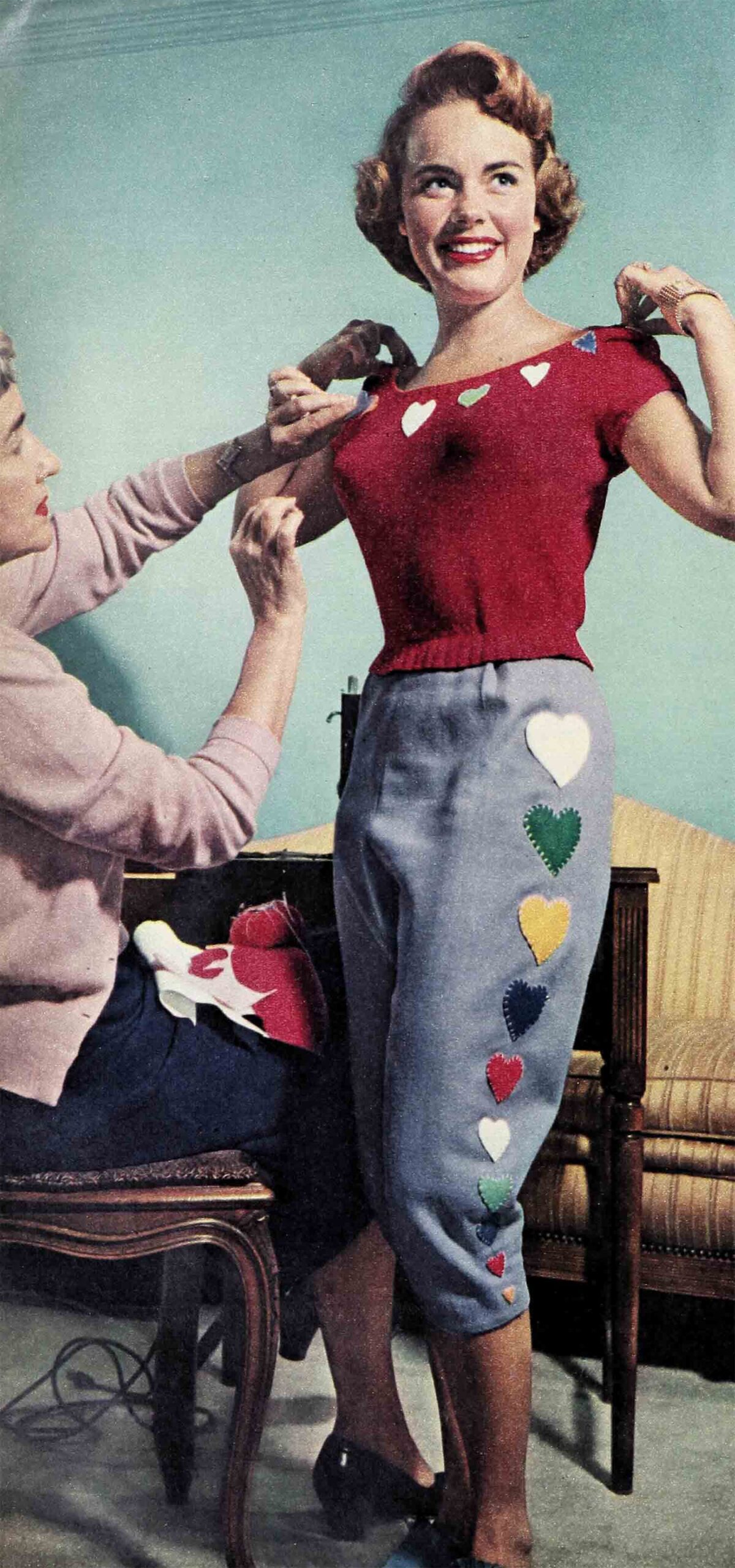
“Sewing at home saves money, when you consider that, although I buy dozens of yards of material for a full-skirted formal for around twenty-five dollars, the same type of dress, naturally more professionally made, would easily cost two hundred dollars in a shop. And then it would need expensive alterations. For Terry has a tiny waistline while her chest measurements are larger than most and she’s hard to fit because she’s barely five feet two. Clothes made at home give her much more individualized colors, excellent long-wearing fabrics and styles suitable for and fitted to her figure.
“And, in addition, if it hadn’t been for our sewing machine Terry wouldn’t have had, several years ago, a lucrative career posing for covers. The photographer would suggest costumes and colors; I’d scurry through the materials on hand and whip up an outfit in an evening. I don’t know how many dresses I’ve made, remodeled, retrimmed; how many separates I’ve devised into complete outfits by adding and subtracting accessories; how many hats I made and remade.
“Terry doesn’t splurge on clothes, but she does on lingerie—which she loves. And when I gently scold her, she reminds me, ‘Look how much money we save on my clothes, and besides, Grandma always used to tell me that a girl should wear pretty lingerie because you never know when you are going to get hit by an automobile!’ What are you going to do with a girl like that?”
What tireless Mrs. Koford has done is accept the challenge of making change-about clothes which do double duty—like separates which look like a dress to the naked eye, tops and full skirts that make cocktail dresses, and at the same time are the makings for several other evening and semidressy outfits. A spray of pink roses tucked into the folds of a black taffeta skirt and a pink blouse make a charming dress. Twin scarfs—one for the throat and another peeping from a pocket—do the same thing.
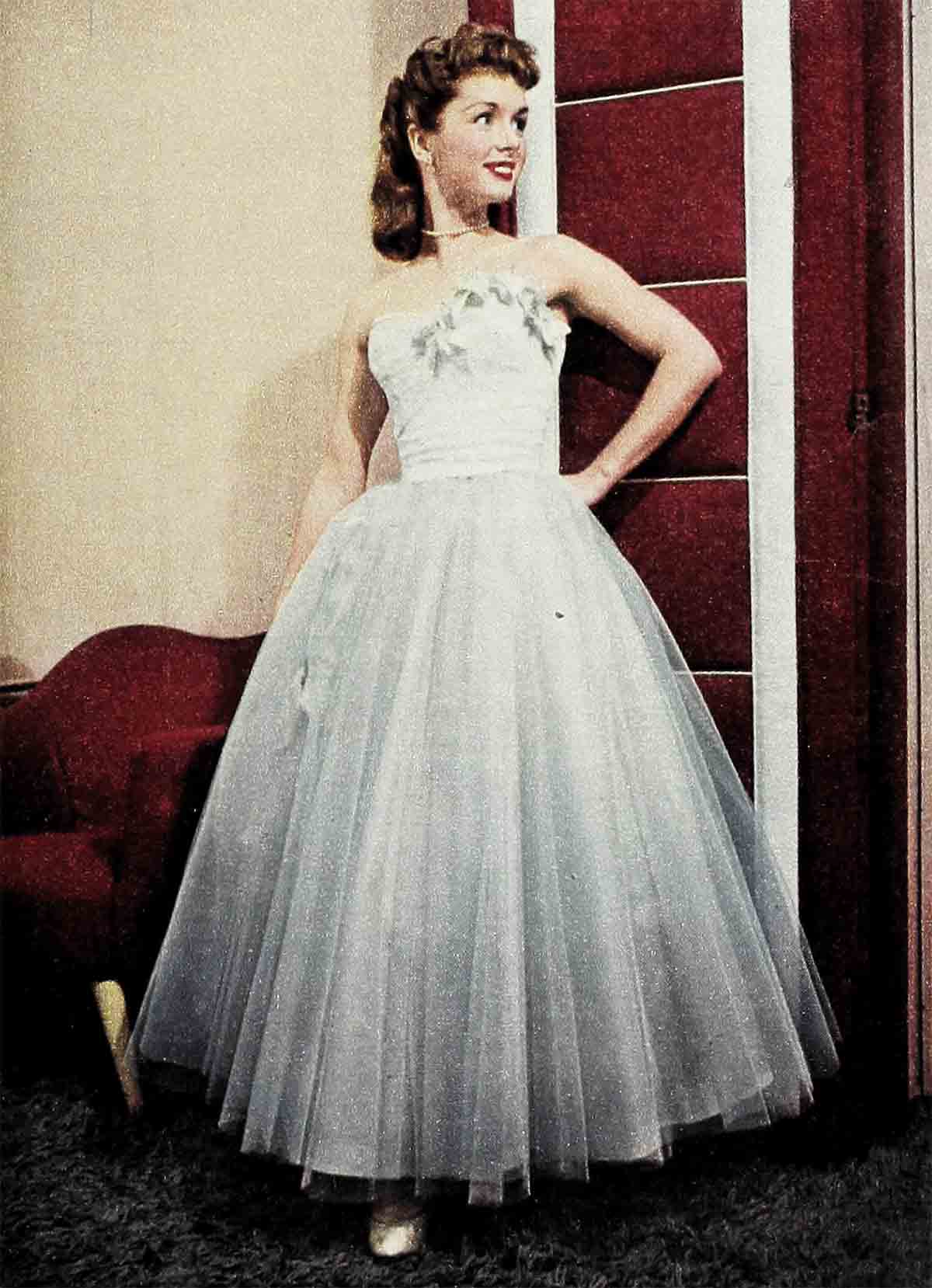
Mrs. Koford is ever on the lookout for unusual ornaments. Using her imagination and creative ability, she makes these into individualized additions to the sophisticated costumes for which Terry, the town’s most dated girl, is noted. When Mrs. Koford found a few yards of an unusual dappled tweed, the colors of autumn, she made a slim sheath, then finished it off by knitting a neckline and cuffs for it. One day when she was passing a shop that catered to horseback riders, her eye caught a large antique-looking brass ornament used on a harness. It cost a dollar. With a brown velvet ribbon drawn through it, it made a striking sweater accessory. Another time, three embossed metal curtain rings, filed open and worn high on one arm, complemented an evening gown. Again, a group of unusual alligator pins which Terry bought in Germany while making a film, are worn at the knee of a gray circular felt skirt. With the skirt, she wears a ruffled red taffeta can-can petticoat which matches the red lining of her favorite long black wool coat.
At a millinery supply house Mrs. Koford bought a little wire Juliet cap, ornamented it with tiny hand-sequinned flowers of bronze to complement a chic bronze and gold net ballerina-length gown. The tiny posies are changed for other evening gowns. She’s also made eye-catching belts of velvet embroidered with pearls and sequins—fun with either full skirts or slim tapered toreador pants. A dime-store pair of cuff links were made into a distinctive accessory for a blouse by cementing on a huge clump of pearls of all sizes. Tweezers and household cement were the necessary tools.
A remnant of blue wool gave her the idea for “television pants.” Bits of discarded colored felt in bright colors were cut out in heart shapes, graduated in size and appliqued down each side of blue-denim trousers. To go with them, a white hand-knitted sweater, years old and turning a bit yellowish, was dyed fuchsia to match one of the hearts and a row of tiny felt hearts outline the neck. In this costume, and other slim trousers worn with very feminine tops, Terry is all dressed up . . . to stay home!

Dozens of cotton sports dresses to set off the tan of sports-loving Terry—as well as unusual bathing suits—are also whipped up at home. One white two-piece bathing suit actually has a turtle neck!
Both Terry’s and Debbie’s mothers have only one complaint about their daughters who effervesce with bubbling vim and unquenchable vivacity—they hate standing still for the necessary pinnings and fittings. Debbie chews away violently on her gum, while commenting in jive talk about the super quality of the dress; Terry’s mind is on the hundred things she is currently planning and should be doing at that moment. Yet both girls are thoroughly appreciative of their good fortune.
For they need an appalling amount of glamour clothes, socially and professionally. Constantly photographed at premieres and parties, they are always under critical appraisal. “I remember once,” laughs Mrs. Reynolds, “when Debbie was wearing for the second time a blue net evening dress with bodice covered with blue forget-me-nots. Camera-carrying fans rushed up to photograph her. ‘Oh,’ sneered one girl, putting away her camera, ‘I’ve got a picture of you wearing that one. Whyn’t you get some new dresses?’
“Even so, Debbie’s clothes overflowed her normal-sized bedroom closets and when she told her dad she needed more room, he said ‘I can’t tear the house down so you can hang up more dresses.’ Then Debbie decided on a campaign. She stopped hanging her clothes up, left them all over the house, draped over her bed, some even piled on the floor. One day Dad glanced in her room, decided a cyclone had passed through. ‘In all my life,’ he said, ‘I never saw such a helter-skelter arrangement of keeping clothes. All right, we’ll enlarge the room and build in an immense closet from wall to wall.’
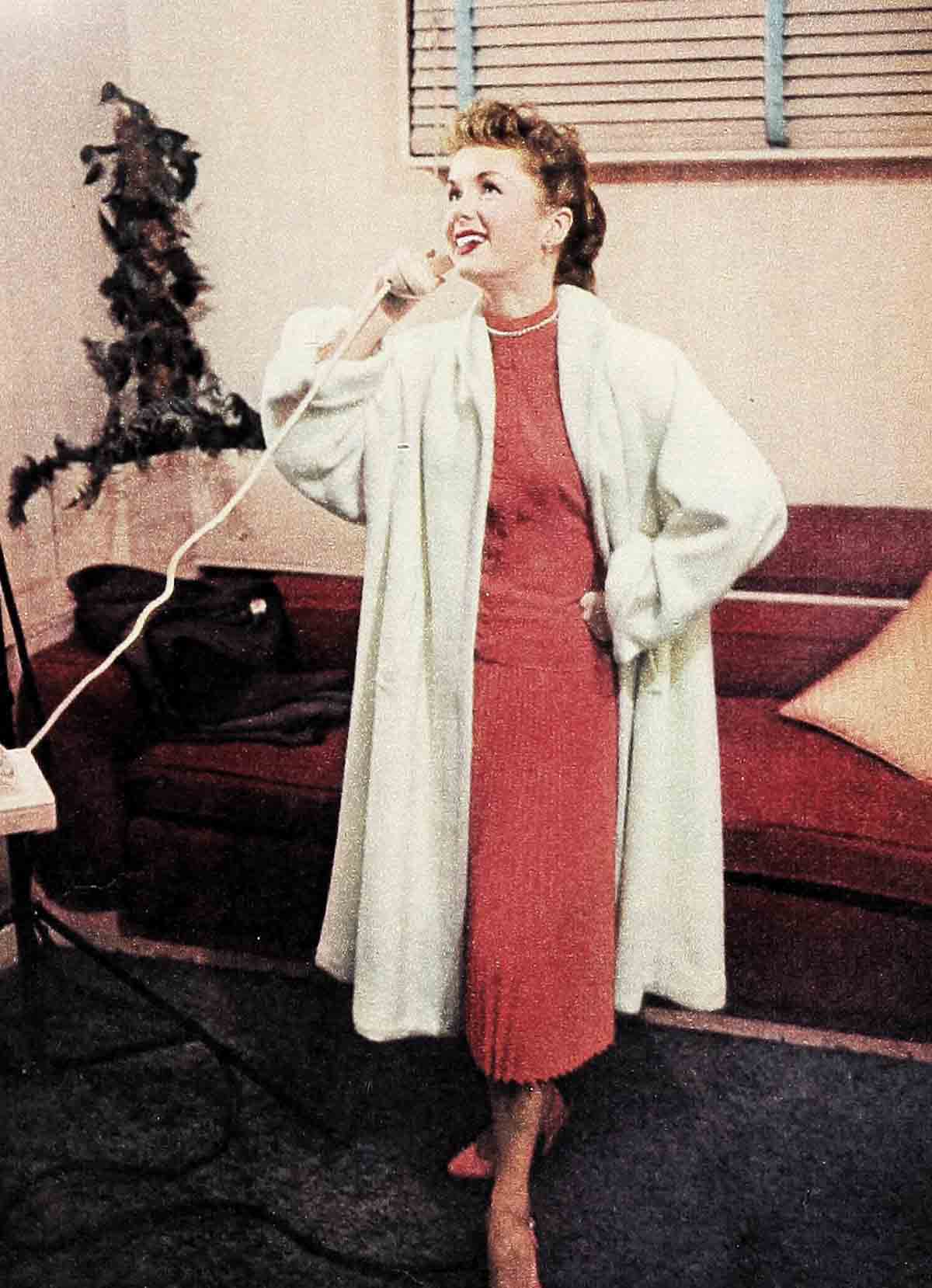
“And do you think that solved the problem? Clothes still spill into the room and it never manages to look tidy. Debbie’s no help—she’ll try on six or seven outfits before feeling that she’s appropriately dressed. And by the time she’s decided, there’s no time to put away the discarded clothes. But she still manages to look neat and tidy. I tell her, ‘Debbie, I’m going to have a long-playing record made that says nothing but ‘Put your things away. Put your things away.’
“Debbie adores clothes; says in the house of her dreams she will have the biggest wardrobe in Hollywood—an entire room piled so full of fabulous clothes that you couldn’t move in it. ‘Anything I want—just go in and pick it out,’ she says. ‘Wouldn’t that be dreamy?’ ”
From all appearances the modest little Burbank cottage where Debbie lives with her family is that dream house. For she has enough clothes to stock a shop. Like Mrs. Koford, Mrs. Reynolds has studied sewing at adult public-school classes. “I started sewing,” Debbie’s young and pretty mother says, “because Debbie was so small and undeveloped for her age. Store-bought dresses swallowed her right up. Now there are dress shops that carry Size five and seven in more adult styles but a few years ago it was impossible to buy things for her.
“When Debbie was sixteen her friends urged her to join them in a local beauty contest. Debbie was less than interested. ‘Look, they’re giving every girl a blouse who enters the contest,’ her friends pointed out. ‘So what?’ asked Debbie. ‘It wouldn’t fit me anyway.’ She did enter, finally, and that was how she got her picture contract. The contract fit, even if the blouse didn’t.”
Though bouncy Debbie is a star, her salary is still low. And she’s lucky to have an inexpensive way to meet her wardrobe problem. Mrs. Reynolds feels that style, anyway, is a matter less of money than of time and headwork and planning. “I try to think of those things Debbie really enjoys wearing,” explains her mother, “those that are ‘all right’ and those that she dislikes. Then I know better what to add. For I’ve found that the clothes one enjoys wearing, especially if one enjoys wearing them after they cease to be new, are becoming. And these items have certain traits in common. Sometimes I copy Debbie’s most becoming dresses—but I always consider the effect of texture on the lines of the dress. If you copy in stiff fabric lines that are perfect in soft material, you’ll be disappointed. Being able to reproduce dresses you’ve loved wearing is just another of the joys of home sewing.”
Debbie’s green-gold eyes gleam and her saucy curls tremble as she models her newest voluminous-skirted gray and silver lamé evening gown. The soft bodice accentuates her twenty-inch waistline and the handmade sheaves of flowers in lamé cascade gracefully down the skirt. The flowers are changed—red velvet for Christmas—other colors to match accessories. “I don’t like low cut dresses but I do like my dresses tight,” Debbie explains. “I only had a bowl of soup for lunch today so that I can get into this dress tonight. I stay around ninety-eight pounds but I do love ice cream sodas. Now and then after too many strawberry malts I have to wait a while before I can get into a favorite dress. When Mother made me a sheath dress recently I told her it was tighter than my skin—I can sit down in my skin but not in this dress!”
The studio gave Mrs. Reynolds a discarded dress figure made to Debbie’s measurements some time ago. “I’ve had to pad the figure a little because Debbie’s measurements have changed in the last year,” she explains. “It saves Debbie’s time because I can do most of the fitting on it. I love sewing. I lose myself in it; forget to put dinner on the stove; and when I hear Debbie’s car come to a squealing stop and that yell ‘I’m ho-oome,’ I can hardly believe that the time’s gone. But the flattering results reveal the hours of careful work which go into the professional-looking results.”
Marge Champion is in the unique position of having a mother-in-law who makes all her stage clothes as well as her personal wardrobe. She possesses some of the most beautiful gossamer-sheer, dancing glitter-encrusted dresses this side of heaven.
Mrs. Champion—Buzzy to Marge—has been making her daughter-in-law’s wardrobe since Marge and Gower, then a struggling dance team, married. “Marge,” she explains, “has well-developed shoulders from her dancing, also a tiny waist and practically no hips. ‘Midget.’ So store-bought clothes, if they fit in the shoulders, hang like a sack below.
“For her night-club dancing appearances I have many things to consider—weight of the dress; its movement when Marge dances; color which changes under stage lights; the type of dance for which it’s to be used. Rhinestones on the side of the bodice, for instance, are taboo, for Gower’s hands would be cut when he lifts her; heavy material in the number of yards to give the necessary fullness to the skirts would make the dress weigh so much that Marge would tire as she danced.”
Each of these fabulous dancing dresses has a built-in wired bra; over that is the intricately tucked and seamed bodice. The skirt which contains as many as fifteen yards of pleated net or organza is as light as a chiffon hankie floating on the breeze. Lace, flower or velvet appliqué, embroidery, sequin, pearl or rhinestone hand needlework are reminiscent of court costumes. And works of art are Marge’s great ripples of ruffled or embroidered or pleated petticoats which swirl like foaming waves beneath her skirt.
One star who loves the thriftiness of home sewing—and takes the time to do it herself—is pixie-faced star of “Lilli,” Leslie Caron, who came from France. Leslie’s childhood was spent in war-ravaged France and filled with want and privation. It was natural to learn sewing but there wasn’t much to work with. When she and her mother arrived here from Paris, they brought only one suitcase because they planned to return after Leslie made her test. But it was decided to make “Lilli” here and Leslie had no wardrobe and no money to splurge on a new one. But the little ballerina was not upset. She rented a sewing machine, haunted the bargain counters for unusual fabrics and proceeded to make herself distinctive costumes—clothes which set off her gamin face, hypnotic eyes and ballerina catlike grace.
Mrs. Champion, Mrs. Koford and Mrs. Reynolds all agree that instruction in sewing classes makes the difference between a made-to-order look and a homemade look in sewing. “Buy the very best materials you can possibly afford if you want the costume to last for years and with- stand repeated cleanings. If you can’t afford the best in a certain type of material, change your plan and buy the best in some other less expensive type,” urges Mrs. Champion. “Of course, the bargain table is a boon—but only if you know quality; remnants are fine, if usable. Learn to adapt the pattern you buy—to individualize it, to bring out your best features and make it uniquely yours. Too many women snatch precious time from their household duties to make aprons or house dresses. These may be purchased for very little; therefore it’s better to use your time making the kind of clothes for your children or yourself which are expensive in shops.
“A dress must be well built to be flattering. And with experience comes the professional touch. It’s no harder to do a smooth job than to bungle one, and once you’ve geared yourself to the professional approach, you’ll find you come up with professional solutions to any sewing difficulties that arise. Trimming must be used as an artist uses his brush. Intelligently applied, trimming makes almost any dress look expensive; it accentuates good lines, minimizes figure faults and brings out fabric color.”
All of these home dressmakers have in common the problem of achieving an effect of height for the girl of small stature. They are careful not to clutter up a small-fry figure with unnecessary detail. Unbroken lines from neck to hem help—also short jackets, fitted sleeves, tiny hats and bags, shortie gloves—everything scaled down to a petite figure, nothing exaggerated or overpowering. But not too plain either. For then the wearer appears drab and insignificant. Thus fine, soft detail with interest centered high near the face adds height as does dramatizing the neckline, the hat, the hair-do. Shorter skirts are girlish and youthful; added length of skirt, instead of adding height, makes the dress look too large for the wearer. The short girl’s clothes should fit perfectly because nothing can cut down height more than a droopy-shouldered, baggy dress. Bright colors, striking detail, not good on the heavier figure, are perfect for the vivacious personalities and definite coloring of these youthful beauties. Most little girls have to be extremely wary of boleros or they risk looking like penguins. But when cut a few inches below the bust-line they make the legs look longer and consequently add height to the entire figure. Since the girl of small stature is frequently inclined to have a high natural waistline, great care must be used in the placement of the belt. The hemline, too, should be placed to avoid showing equal lengths of leg, skirt and blouse. High heels add to height and flatter pretty feet and ankles, and standing tall adds inches also.
But when these home dressmakers sew for tall girls among their relatives and friends, they’ve learned that chandelier-brushing gals get most of the breaks in dressing smartly because they show clothes off to advantage and they can wear important and dramatic costumes that the short girl finds hard to carry. Dramatic for the tall girl are large splashy prints which appear to cut down height or a diagonal panel with hip drape; suits with long torso jackets break up the tall figure; big balloon sleeves and back-flaring jackets help too. Hats with brims add width and balance and pancake-crowned hats are excellent too.
Tall girls must remember to balance the figure by means of longer tunics, fuller sleeves, huge pockets, deeper peplums, enormous shoulder-strap bags—all “big” details that break up long body areas and appear to create width.
“One important point for tall girls to remember,” says Mrs. Champion. “Never wear clothes that fit too tightly or you will look even bigger than you are. Allow for an extra inch or two of ease especially through the skirt and over the bosom. In addition, never stoop or slouch to look shorter. Stand erect. For stooping will never make you look petite. All it does is make your figure look hunched and droopy and your clothes look as if you’ve slept in them. And don’t feel that you must slosh around in flat-heeled shoes all the time. Of course high heels add inches, but they also make the feet look pretty and the legs more shapely. I don’t care if the doctors say high heels are bad for you!”
Further, these girls know that the more consideration given to clothes before wearing them and while putting them on, the less thought need be given them while they are being worn.
And that is why this quartet of lucky dolls really allot enough time to grooming and dressing properly—and emerge looking as though they had just stepped out of the pages of a fashion magazine.
It is a quote. PHOTOPLAY MAGAZINE MAY 1954


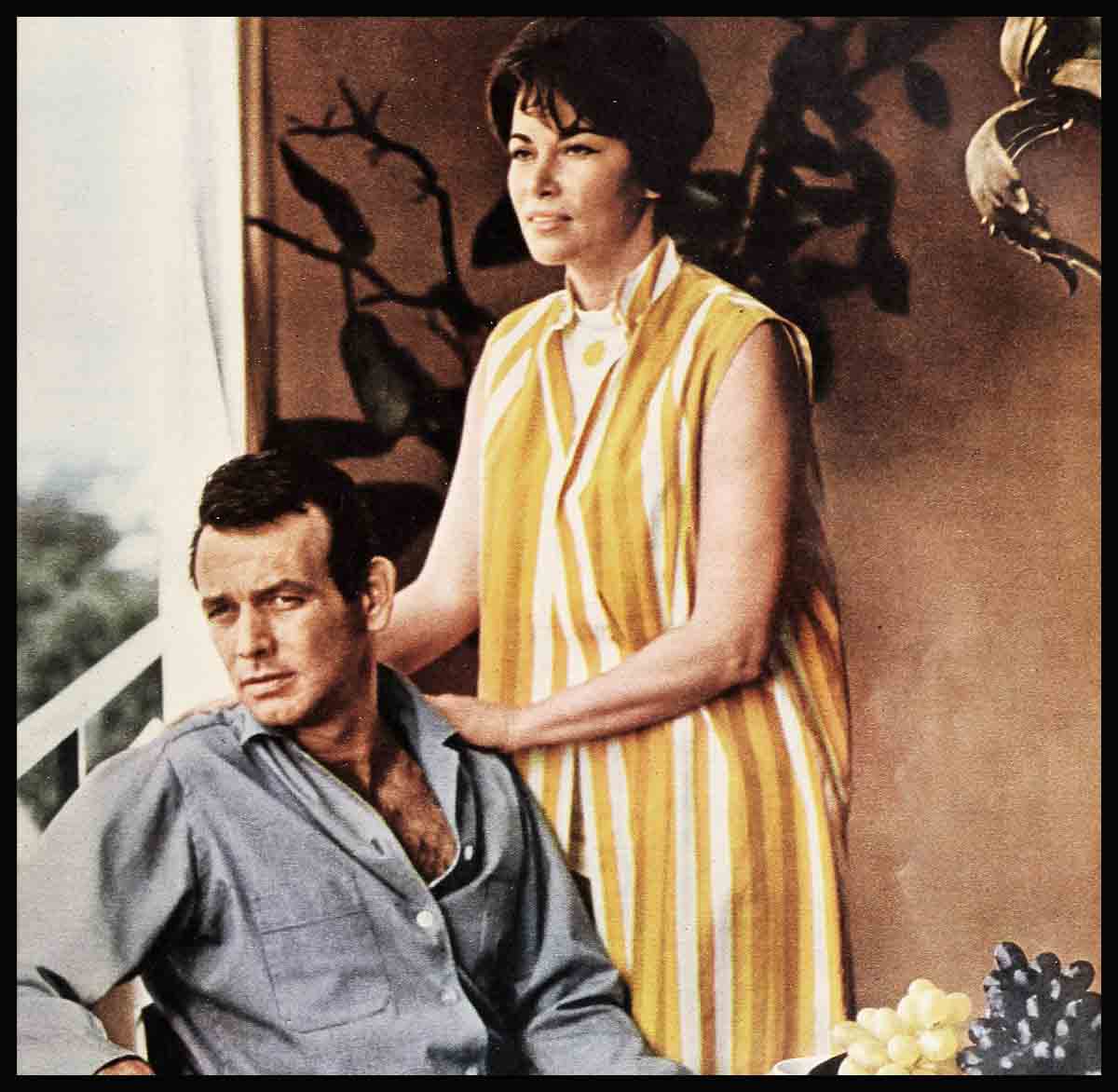

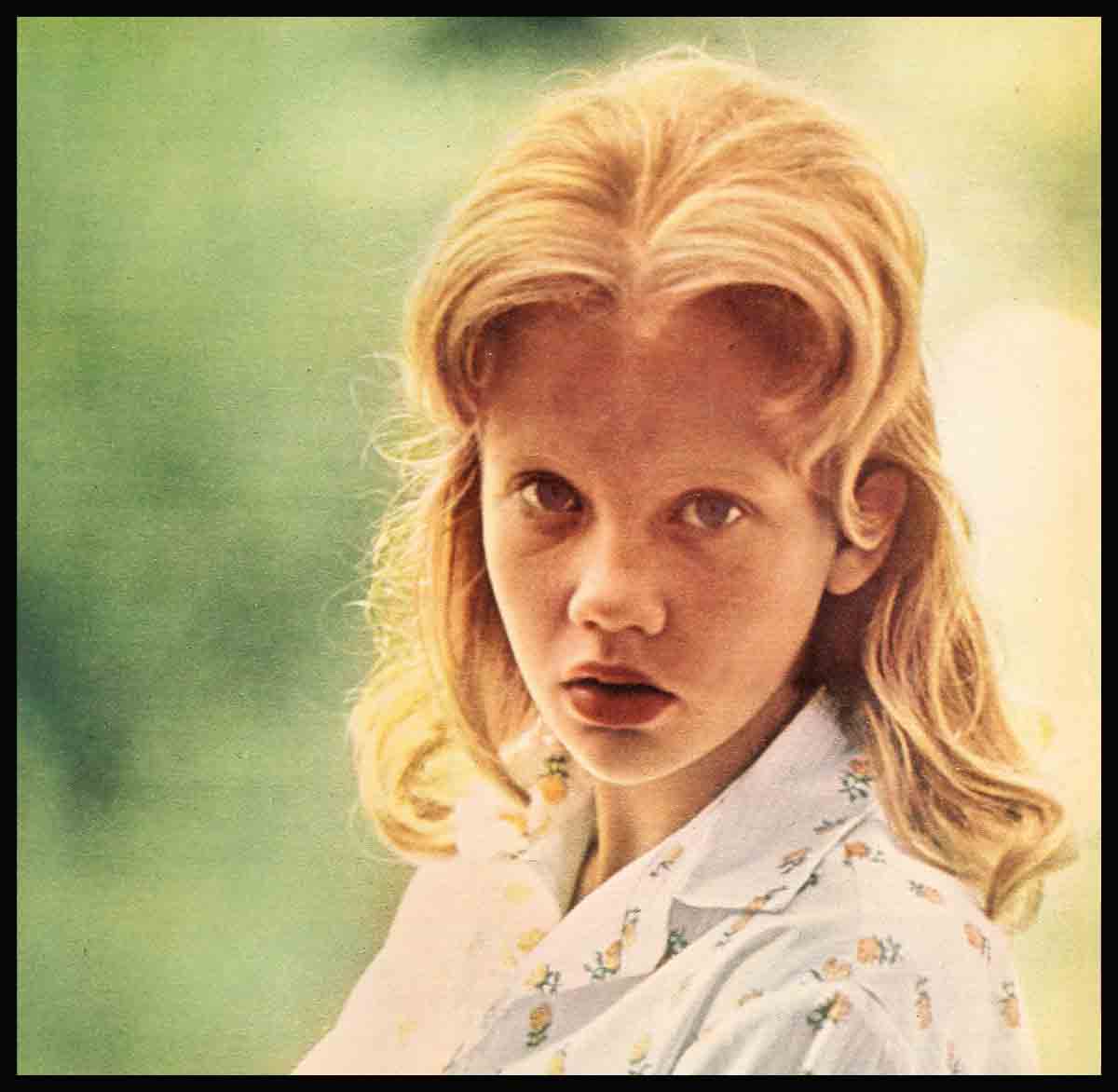
No Comments